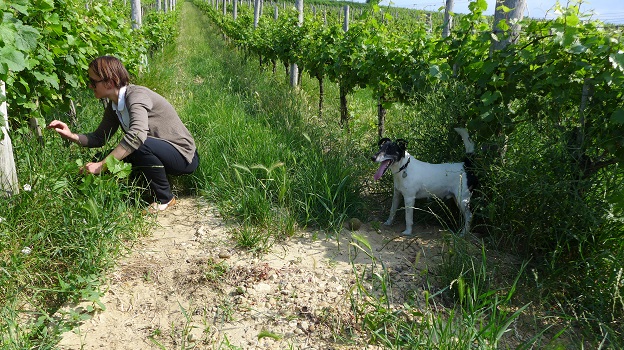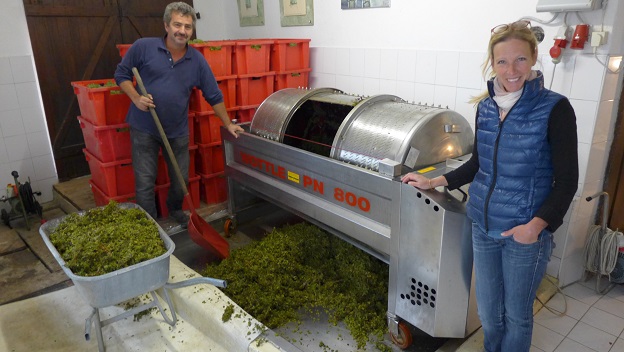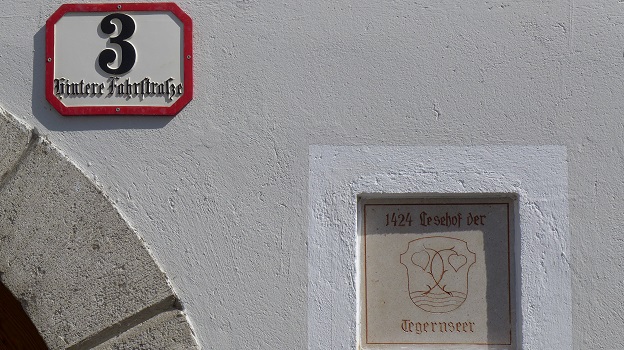Browse using the new Vinous website now. Launch →
Printed by, and for the sole use of . All rights reserved © 2015 Vinous Media
Austria 2014: A Catastrophe? Not Qualitatively!
At several stages, the 2014 growing season in Austria’s Riesling and Grüner Veltliner-dominated growing regions offered a near mirror image of conditions in 2013. Yet, meteorological opposites though they often seem when viewed on a month-by-month basis, each ended-up delivering wines comparatively high in dry extract, pronounced in acidity and low in alcohol. The deviations from the norm in 2014, though, were extreme. And only very selectively could growers achieve ripeness and depth of flavor—not to mention aromatic and textural allure—that could be compared with the norms of downright sensational 2013.
Prime acreage of Riesling and field blends on Vienna’s Nussberg
A Rainy Year With a Small Crop
The 2014 vintage presented the greatest challenge to building must weights since at least 1994 (some growers would say since 1987 or 1984); the greatest challenge from rot since 1998; and the cumulatively rainiest weather in memory. The upshot at many estates was a harvest one could well call catastrophic—in bottom-line economic terms, that is. At many estates only a pathetically small volume could be painstakingly picked at the highest labor costs ever recorded. Qualitatively, though—albeit improbably, given the odds—the story is dramatically different. At most top addresses, a majority of 2014s are delightfully distinctive, and not a few of them memorably so. The 2014s may also shock someone who did not experience typical Wachau, Kremstal or Kamptal wines of the 1980s, when acidity levels were typically pronounced and alcohol rarely exceeded 13%.
A vivid impression of the challenges of the 2014 growing season can be gleaned from even a superficial glance at what various Wachau growers chose to bottle. The spread of must weights this vintage would not have been deemed exceptional had they been recorded in the late 1980s—the first years in which the three weight classes of Steinfeder, Federspiel and Smaragd were differentiated—and would then have resulted in collections dominated by Federspiel but happily boasting a significant share of Smaragd. In 2014, though, many growers were concerned that wine lovers have become too accustomed to richness and stuffing to accept as either Federspiel or Smaragd wines that analytically approach the lower limits set for those categories. As a result, wine from many sites that have over the past two decades consistently delivered dedicated Smaragd bottlings was this year bottled as vineyard-designated Federspiel, or blended into village-designated cuvées. And in lieu of village-level Federspiel, many growers chose to chaptalize, thus forfeiting the right to utilize any of the Vinea Wachau’s trademarked trio of stylistic descriptors. That having been said, some growers bottled their typical ranges, if at Smaragd level often in painfully small volumes. This enormous variation from one Wachau portfolio to another reflects not only the aforementioned decisions regarding style and labeling, but also local meteorological conditions and viticultural knack.
Jutta Ambrositsch in her vineyard with Edgar
The 2014 Growing Season and Harvest
The winter of 2013-2014 was not only mild but brief. Spring arrived so early and warmly that growers initially feared that their vines’ precocious growth might be killed off by frost. But there was none. On the contrary, unusually high temperatures and low precipitation persisted through April. Then the heavens let loose. In May alone, even with a late start, rainfall in most of eastern Austria reached a monthly total last surpassed in 1820. On top of that, it was the coolest May in decades. June and July, though, began to look as if the weather had locked into the hot, dry pattern of 2013. There were to be some heat spikes sufficient to disrupt vine metabolism, but not flowering, which was quick and complete. As in numerous recent years, there were more—and more vicious—localized hail storms than usual this spring and summer, Vienna’s Right Bank vineyards having been especially hammered in May. August went back off the rails with cloudy, intermittently rainy weather, which segued into regular downpours throughout September.
“On October 1,” related Ludwig Hiedler, “we had 40 liters of rain (per square meter) inside of an hour and a half, a storm so heavy you couldn’t even see across the street. Eighteen degrees Celsius (64 F.) it was like a tropical cyclone. The vines were still green, so they pumped water, putting pressure on the berries.” “In many cases,” related the Weinviertel’s Ingrid Groiss, “the berries simply burst. And when that happens, there’s nothing you can do” to salvage the affected bunches. Only after the first week of October did any consecutive days with clear skies return, leaving most quality-conscious growers battling botrytis yet wishing for additional hang time to lift the must weights of those clusters that remained healthy. The weather gods largely obliged, though in many instances, especially with Riesling, botrytis had advanced too far to allow growers to put off picking, or had infiltrated the collective bunches too uniformly for conventional sorting, however rigorous, to be effective.
Wildly Varying Quality
in 2014
Extreme though it was, the 2014 growing season serves as a warning against the inevitable but misleading temptation to judge fruit-ripening potential too anthropomorphically. An August bereft of al fresco dining or outdoor swimming weather can be very much to the liking of grapevines, provided that just enough light accompanies an ample supply of water, and temperatures do not become outright frigid. Indeed, in several recent vintages—by no means only in Austria—a relatively cool, wet August has successfully applied the brakes to a season that looked set to deliver too much grape sugar too quickly. Phenolic ripening and diminution of malic acidity can progress even if September remains overcast and rainy. Indeed, it was grape sugars that lagged behind ripe flavors in 2014; in recent years it has been the other way around.
Leo Alzinger Junior reported of his 2014 crop that, at a two-to-one ratio, tartaric acid dominated over malic to the same degree as in 2013, albeit at a level of total acidity surpassing even that of 2010. And given so much rain, off-the-charts levels of acid-buffering dry extract were accumulated. All of this having been duly noted, though, there is still more than a little mystery to the clarity and complexity displayed by the best 2014s, in some instances despite botrytis that their growers testified was too pervasive in each and every cluster to be at all thoroughly culled. Fritz Wieninger summed up this sense of mystery shared by most growers: “We didn’t by any means anticipate at the time of harvest the sort of quality we ultimately achieved.”
But before any of us becomes carried away with the improbable success of so many 2014, consider this measure of this vintage’s challenges: some dozen prominent Wachau, Kremstal and Kamptal growers whose wines I tasted do not put in an appearance in this report (though several of them did in my report on 2013), because even their wines from top sites displayed excessive volatility; underripeness or rot-tinged fruit character; acid imbalance or awkward de-acidification. Moreover, the tiny but labor-intensive crush of 2014 bled red ink all over every winery balance sheet, and even growers who ended up surprised, even delighted, with their results hope never to relive a year like this. “I wish I could have this vintage’s virtues every year,” exclaimed Martin Mittelbach tellingly, “but not for the effort and crop loss it cost me.” “Usually there is a certain wistfulness,” noted Alwin Jurtschitsch, “when we finish picking the last parcel and gaze out across that amazing Kamptal vista. In 2014, all we could think was: ‘Thank God it’s over!’”
Success Required Luck As Well As Skill
Vines had to be pruned and crops managed so as to achieve a knife-edge balance going into late summer. Too many bunches meant they would never decently ripen; too few promoted berries that would burst from water pressure. September rainfall in the Kamptal and nearby portions of the Kremstal was less massive than elsewhere, particularly in the Wachau, where it tended to worsen as one moved west. And yet, as my ratings demonstrate, many growers and sites in the Wachau managed somehow to compensate with a vengeance. At most addresses, Grüner Veltliner held an edge over Riesling given that the former typically ripens earlier and with more robust skins, both factors limiting its susceptibility to botrytis. In consequence, some growers ended up picking Riesling before Grüner Veltliner rather than in the conventional order. And yet, there were growers for whom Grüner Veltliner proved more problematic. The longer one let fruit of either variety hang, the more likely it became that picking would be frantic at the point where accelerating botrytis looked likely to turn the tables on quality.
An excellent example not just of the improbable success possible in 2014 but also of how substantially circumstances varied from one site or estate to the next can be found by taking as a canary in the coal mine Gelber Muskateller, the local Muscat that has staged a well-deserved rebound in popularity and acreage in recent years throughout the regions under consideration in this report. Here is a grape notoriously sensitive to rot; prone in bottle to angularity, tartness, drying and bitterness; and demanding patience if it is to be harvested so that its green herbal pungency is accompanied by scents and flavors of orange and apricot. Small wonder, then, that confronted with 2014’s conditions, some growers threw up their hands in advance and wrote off Muskateller so as to devote full attention to saving their cash crops, Grüner Veltliner and Riesling. Yet, among growers who persevered with Muskateller, while some wines are predictably disappointing, others are among the most fascinating and delightful that I can recall from this cépage thanks to their buoyancy, brightness, vivacity, focus, and infectious juiciness—all traits that characterize the best wines in this report generally.
In principle, pre-fermentation skin contact (which elevates pH) as well as post-fermentation contact with buffering lees can compensate for extreme acidity while simultaneously increasing overall complexity and textural allure. But neither of these remedies made sense unless one had managed to cull, to work around, or somehow work with any botrytized fruit. Malolactic transformation is not uncommon in many of the cellars covered in this report. But in 2014, the results were sometimes awkward, and sometimes the pHs were too low for the malolactic bacteria to get a foothold. Contrary to expectations, among the relatively small share of wines (typically generics) that successful growers confessed to having lightly de-acidified as musts, I encountered few that had sacrificed bright citricity or primary juiciness. (Major acid adjustments to young wines were another matter, but one largely confined to estates whose 2014s did not make the cut for my report.) And although the lower price echelons among growers’ 2014s are understandably not as replete with amazing bargains as they had been in 2013, there are still many delicious values, not to mention surprisingly few outright green-tasting wines, to be found among them.
Outside Lesehof Stagård
Disparities in Bottling and Picking Dates
Some wines from growers who commenced at the earliest possible break in the rainy weather support their assertions that the season’s early start, warm mid-summer and long hang time sufficed for adequate phenolic ripening. But even among early harvesters, many elected to bottle their wines later than normal to allow longer time on the lees and greater acid-reducing tartaric precipitation. Rudi Pichler, whose collection is among this vintage’s most consistently impressive, took a contrasting approach on both counts. “You had to put off picking until the grapes had achieved balance and ripeness already on the vine,” he insisted by way of explaining his November harvest. “In that case, no special measures or handling needed to be undertaken in the cellar, which could anyway never have substituted for harmony in the must. Nor would there then be any point in postponing bottling.” Growers confronted with similar circumstances took very different decisions and directions, and given the success that they managed collectively to achieve, an important take-away from vintage 2014 is this: Just as there are many ways to miscalculate or screw up in your vineyards and cellar, there can also be multiple paths to success.
Many single-site successes of 2014 are undoubtedly worth cellaring. But a cautious approach is in order, especially since negative influences of botrytis often become noticeable only after the wines have been in bottle for a year or so and their effusively youthful fruit has dimmed. What’s more, many wine lovers are liable to find that in retrospect they preferred to enjoy this vintage’s levity and prominent acidity when it was backed up by maximum primary fruit and youthful succulence. Even those 2014s that end up rewarding extended cellaring may well pass through some awkwardly angular stages on their way to secondary complexity and textural patina. For all of these reasons I have chosen to be especially conservative in my prognostications of ageability, and suggest that these be taken with even more than the usual grain of salt.
The Contents of this Report
The present report relies on my impressions from visits with 70 growers in late May, early June and late September, supplemented by a few later tasting sessions staged to give questionable collections or individual wines the benefit of a doubt (though few of those rose to the occasion). While the notes record my most recent impressions of any given wine, they sometimes also reflect relevant aspects that I noticed on first acquaintance from tank or cask. In those few instances where I have not tasted a wine since bottling, I offer a point spread in lieu of a specific score. With only a couple of exceptions, notes in this report on wines of vintage 2013 or earlier reflect late releases that are currently or will soon be on offer at the cellar door. Notes are almost never included for wines that I rated less than 87 points, the rare exceptions being instances where I deemed it important to convey my concerns about a particular wine.
For additional details and personal impressions of the estates covered in this report, I refer readers to the extended introductions supplied for each grower as part of my early-November report focused on vintage 2013, in which many of my tasting notes also include information about the sites farmed and methods employed. Such details are included in the present report only for estates that were not covered in my inaugural report, either because I was late completing my assessments or because I tasted few if any of those growers’ 2013s. Absence of coverage should not be taken as reflecting negatively on any of the following estates that appeared in my vintage 2013 report, because these are ones whose 2014s I have not yet had a chance to taste—or not in a sufficiently finished form: H.-M. Lang, Irene Langes, Leindl, MG Vom Sol (Michael Gindl), Söllner. The general introduction to that earlier, 2013-focused report also offers an account of conventions observed in my reports for naming wines, in particular regarding certain details often found on Austrian labels that I consider superfluous for purposes of identification and therefore omit.
You Might Also Enjoy
2013: A Great Vintage for Austrian Riesling and Grüner Veltliner (DS)
-- David Schildknecht
Show all the wines (sorted by score)
- Allram
- Anton Bauer
- Barbara Öhlzelt
- Bernhard Ott
- Birgit Eichinger
- Bründlmayer
- Buchegger
- Domäne Wachau
- Ebner-Ebenauer
- Ecker - Eckhof
- Fritz Salomon - Gut Oberstockstall
- Fuchs und Hase
- Gritsch Mauritiushof
- HarmWein
- Herbert Zillinger
- Hiedler
- Hirsch
- H. & M. Hofer
- Ingrid Groiss
- Josef Ehmoser
- Jurtschitsch
- Kurt Angerer
- Lesehof Stagård
- Leth
- Loimer
- Markus Huber
- Nikolahof Wachau
- Petra Unger
- Pollerhof
- Pur
- Quantum Winery
- Rainer Wess
- Schloss Gobelsburg
- Setzer
- Stadt Krems
- Steininger
- Stift Göttweig
- Veyder-Malberg
- Vorspannhof Mayr
- Walter Wien
- Weinberghof Fritsch
- Weingut Alzinger
- Weingut Artur Toifl
- Weingut Christ
- Weingut Edlmoser
- Weingut Emmerich Knoll
- Weingut Franz Hirtzberger
- Weingut F. X. Pichler
- Weingut Geyerhof
- Weingut Josef Jamek
- Weingut Jutta Ambrositsch
- Weingut Ludwig Ehn
- Weingut Malat
- Weingut Mantlerhof
- Weingut Martin Diwald
- Weingut Martin Muthenthaler
- Weingut Neumayer
- Weingut Nigl
- Weingut Pichler-Krutzler
- Weingut Prager
- Weingut Proidl
- Weingut Rudi Pichler
- Weingut Salomon Undhof
- Weingut Sepp Moser
- Weingut Tegernseerhof
- Weingut Thiery-Weber
- Weingut Wieninger
- Weinhofmeisterei Hirtzberger




